Rock influence on landscape and human activities.
It is obvious and true that land forms
and relief features result from a combination of processes such as earth
movements, volcanism, weathering, the action of running water, ice waves and
wind. These processes have been important in the past and are very important in the moment, yet on their own, they cannot
adequately explain changes that occur in the landscape.
Each rock type and each structural features is capable of
producing its own characteristic land
forms. Everywhere on earth, there is a close relationship between rocks and
landforms.
(a)Batholith
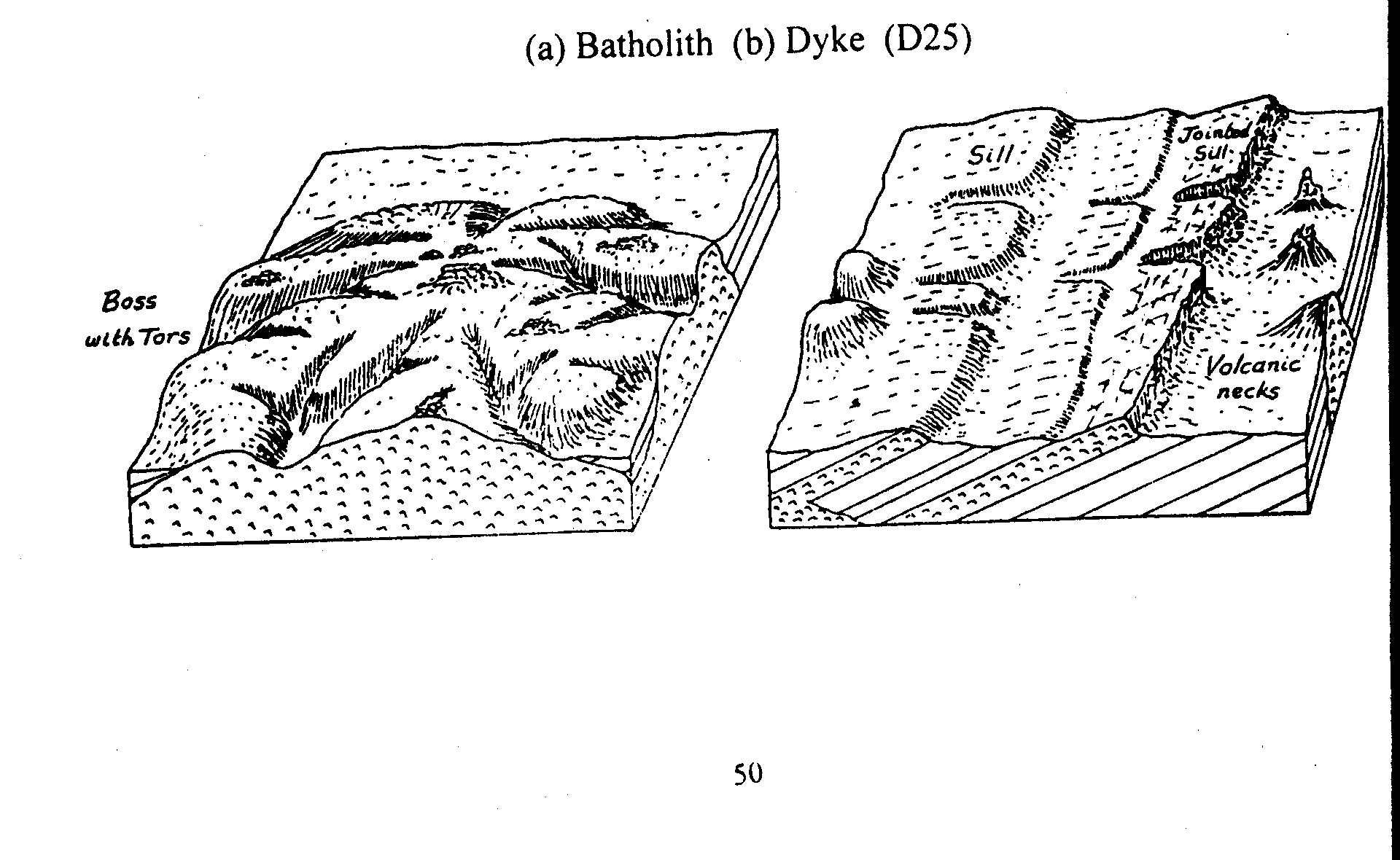
Rock Types and Relief.
The influence of rock types on relief here refers to the
nature (or kind) of relief which is produced by each rock types.
Igneous
(Volcanic) Land forms.
Volcanic activity results into two categories of land
forms:
a. Extrusive Land forms.
b. Intrusive Land forms.
Extrusive features.
Volcanoes.
These are produced when lava piles up to
form volcanic cones or mountains. If the lava is acid, it forms high and steep
sided mountains or cones. A typical example is Mt Muhabura at the South West
corner of
If the lava is basic, it is runny
(fluid) and flows over long distances before solidifying. The result is a low,
gentle sloped mountain with a very wide base. Mt
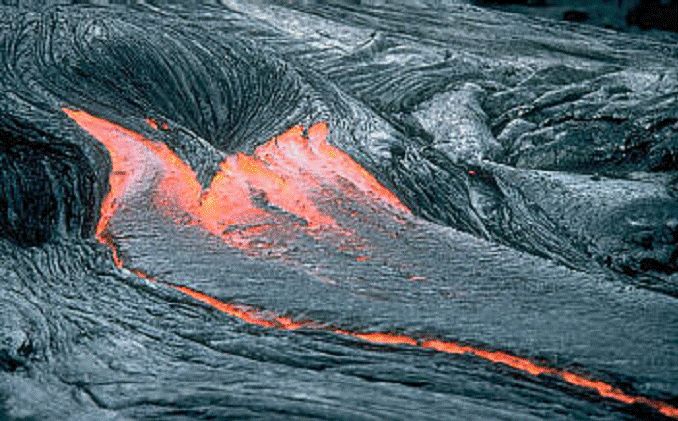
Extrusive Landforms (D 26) Ash and cinder cone
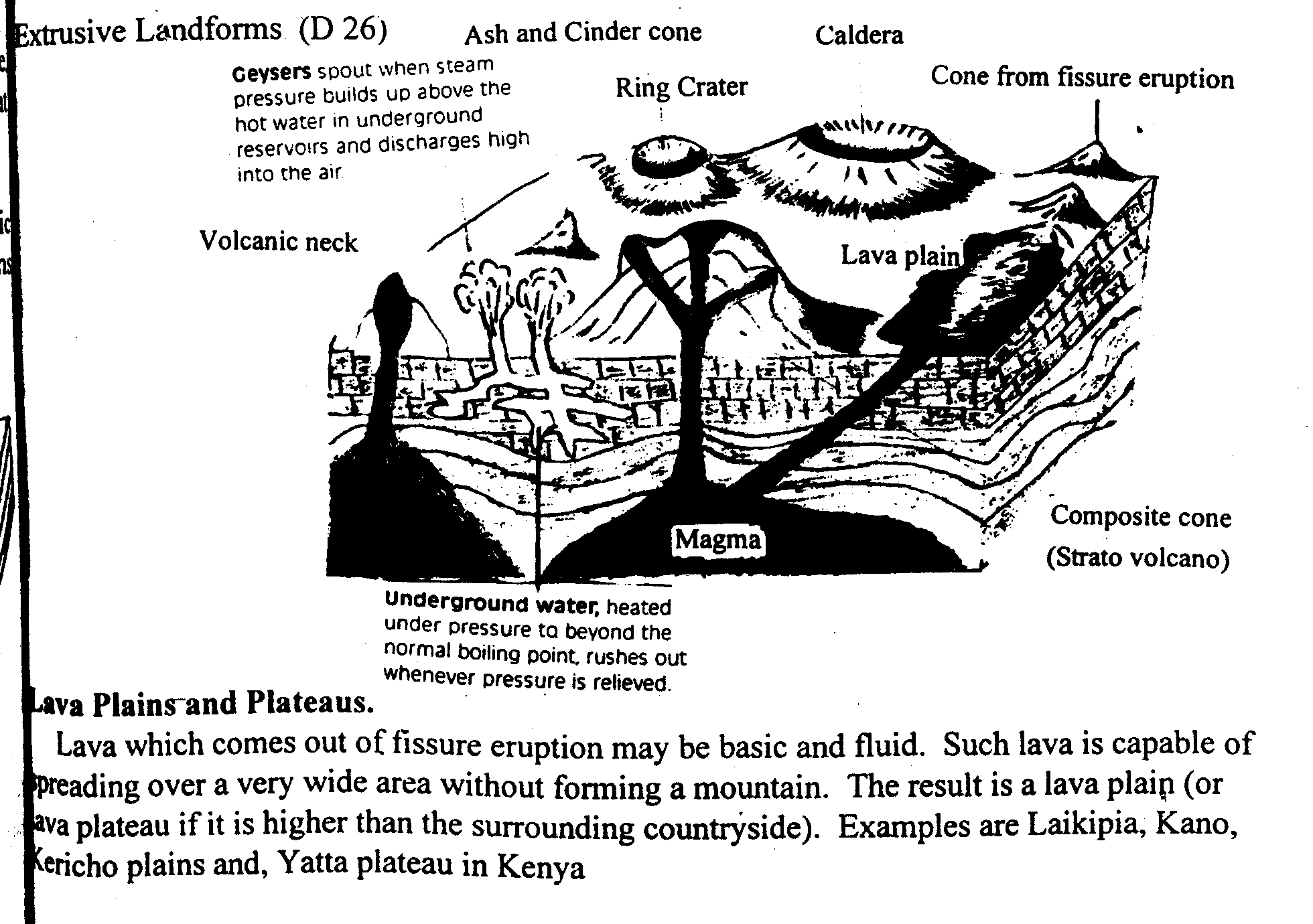
Lava
Plains and Plateaus.
Lava which comes
out of fissure eruption may be basic and fluid. Such lava is capable of
spreading over a very wide area without forming a mountain. The result is a
lava plain (or larva plateau if it is higher than the surrounding countryside).
Examples are Laikipia,
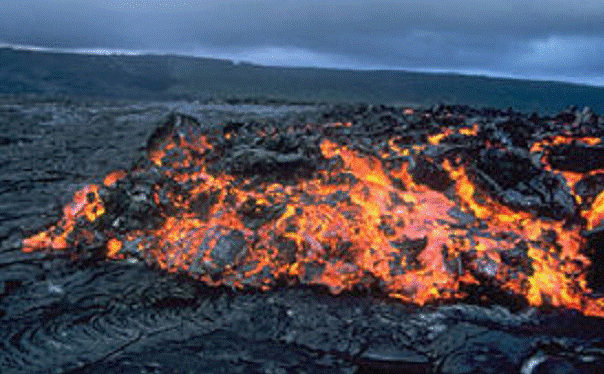
Figure 4: This flowing lava is an
example of molten mineral material. It will harden into an igneous rock.
(Source: http://en.wikipedia.org/wiki/Lava,
License: GNU
Free Documentation)
Geothermal Activities.
These are minor features which do not
affect relief, and they include
Intrusive volcanic activity usually does
not produce immediate relief features except when they occur very close to the
earth's surface. In such cases, domed structures like those surrounding the arenas
of Ankole, and Bosses like those of Mubende are created.
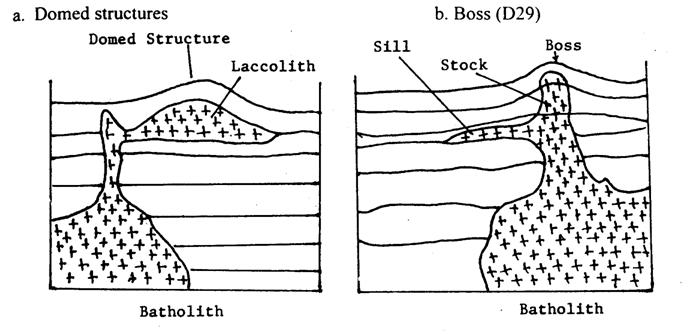
Generally, however, intrusive land forms
affect relief only after they have been exposed by denudation, and thus to a
large extent depends on their resistance. The main land forms and relief
features are:
(i)
Batholiths.
These are huge and massive intrusive
granites which extend deep into the mantle below the crust. They have been
exposed by denudation, and form low relief features. They are found in Singo in
(ii)
Sills and Dykes.
These intrusive igneous rocks when
exposed by denudation also form relief land forms. Sills outcrop over large
areas of West Nile in
Dykes are more numerous in
Craters, Calderas and Ring Craters.
These are hollow land forms
(depressions) formed by explosive eruptions. A depression less than one
kilometre in diameter. It is formed when an explosive t blows off the top of a
volcanic mountain. A caldera is similar to a crater, only wider, usually
more than one kilometre in diameter.
Crater Caldera (D27)
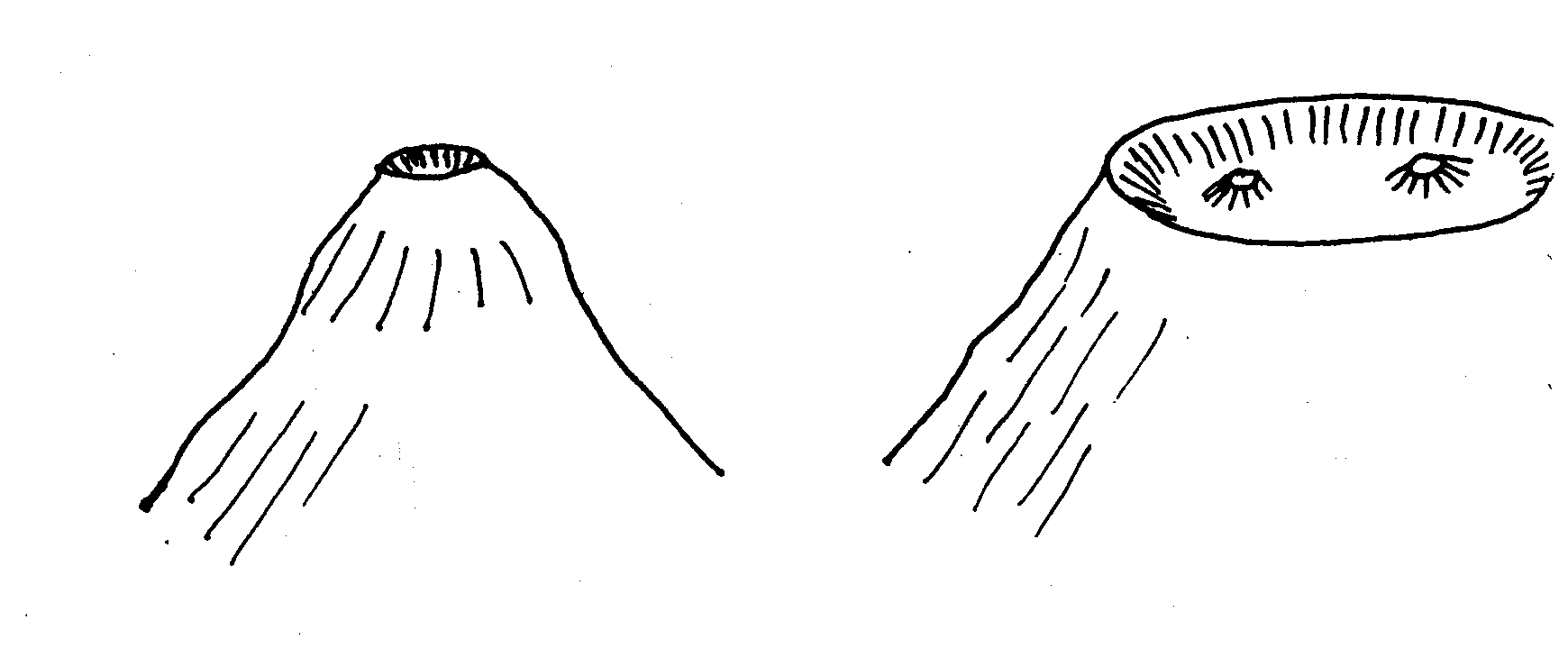
Craters in East Africa are found on top
of
N.B:
The crater on top of Mt Longonot is frequently classified as a Caldera.
F..also known as explosion vents. They are shallow flat floored depressions sum
low rim of ash or cinder. They are formed when gas eruptions drill holes
through a process known as fluidisation). Several explosion craters occur in
Western Uganda Lake Katwe,
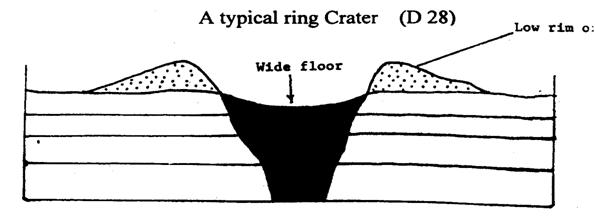
down much faster than the surrounding countryside,
resulting into linear trenches imposing
Doinyo Sapuk which rises to 2,146 metres may also be part of a larger
cone.
Laccoliths are domed intrusive igneous features. When
exposed, they produce rocks like the one near Voi, Lion rock in Kitui and
Buyanga hill (Bunyonro), all in Trench and Ridge landforms from dykes of
different hardness.
a.
Trench b. Ridge
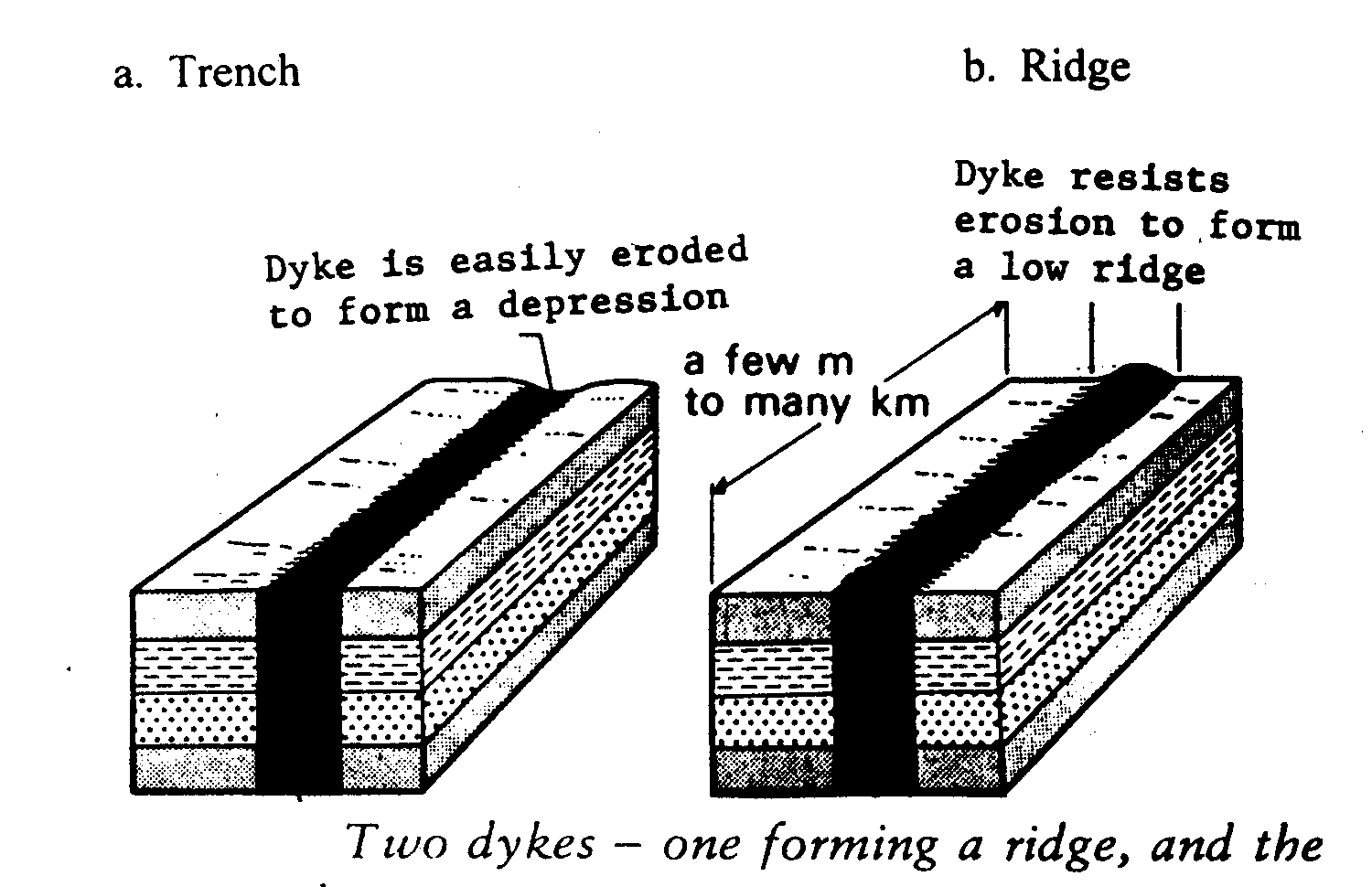
Two dykes – one forming a ridge,
and the other depression
(iii)
Inselbergs.
Various inselberg (residual hill)
landscapes are produced when intrusive granites
exposed by erosion. These include granite tors castle Kopjes, bonhardts,
etc. Of tors and castle Kopjes are most numerous. Examples are the granite tors
in Mub Kachumbala, and Nakasongola, in
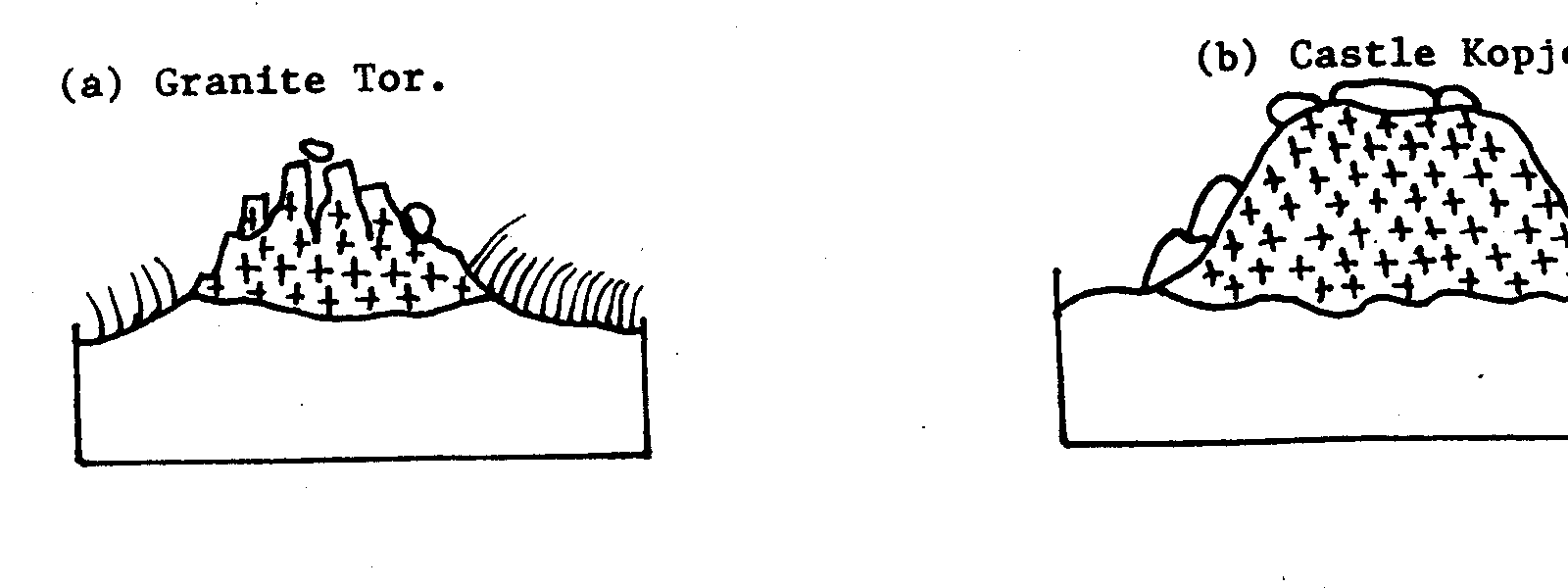
Land
forms from Sedimentary Rocks.
The dominant land forms and relief features from
sedimentary rocks are the following:
(i)
Fringing coral reefs which formed when
sea level was higher than at present have been exposed at various places along
the coast, where they have formed coral platforms e.g the raised Pleistocene
coral platforms at
Corals have also formed barrier reefs
along much of the East African coast extending from the Kenyan coast down along
the Tanzanian coast into the
Where corals lie inland as at Bamburi in
(ii)
Karst Topography (limestone features).
It is interesting to note that a lot of
igneous activity in East Africa involved materials rich in carbonates
(Carbonatites) e.g Dana and Kambe limestones in Kenya, the carbonatites of
Tororo extending into Karasuk in Karamoja, and the Tanga limestones of
Tanzania. In these areas, as in others areas of carbonatite rocks, chemical
weathering has produced characteristic Karst topography. On the western slopes
of Tororo rock, bapters features and grykes and dints can be seen. Similar
features have also been formed on the Kambe rocks at Kilifi in
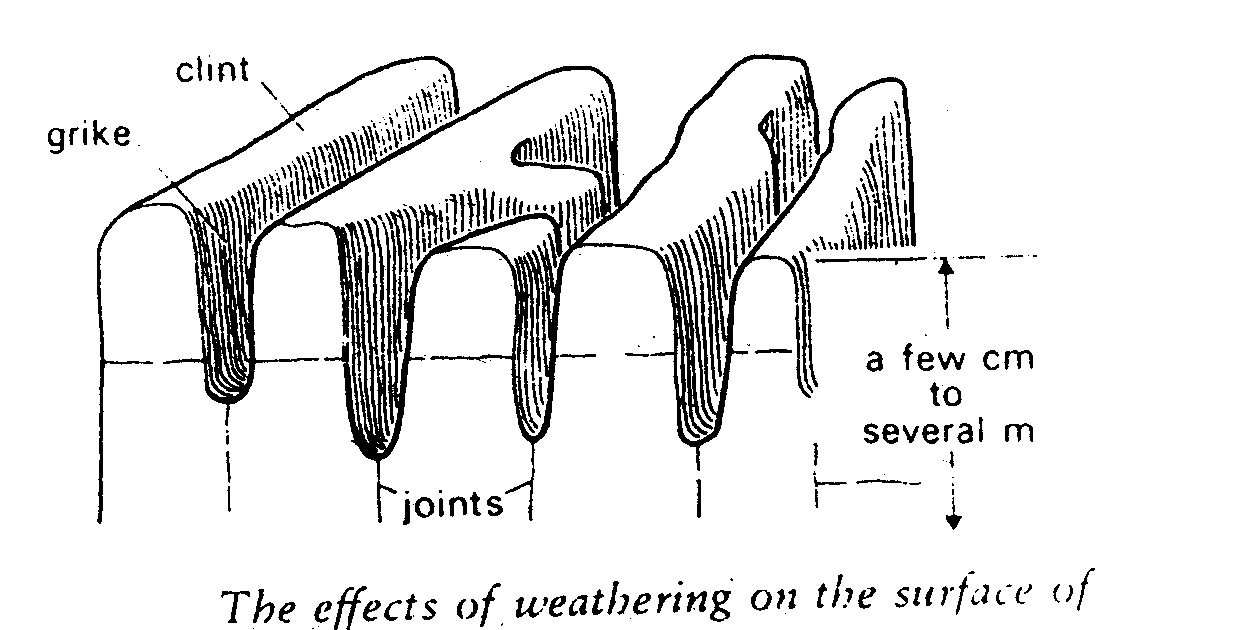
The effects of weathering on the
surface of limestone rocks
At Nyakasura in
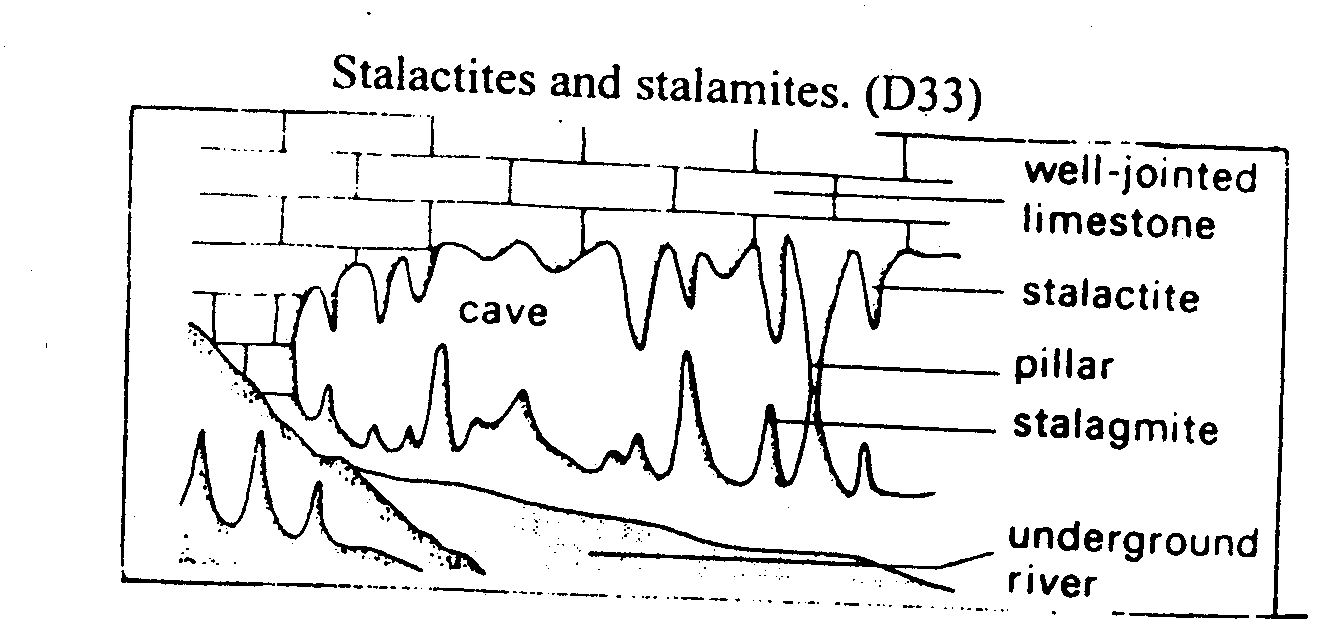
An interior
view of a limestone
cave showing a stalactite, a stalagmite, a pillar and a cave Alluvial Features.
Several features have developed from
both fluvial (river) and lacustrine (lake) deposition . Most of these developed during Tertiary and
Quartanary periods. The major lacustrine deposits include Lwera flats around
Riverine or fluvial deposits are more
widespread. They include alluvial fans, deltaic deposits, flood plains and
levees.
Alluvial fans are numerous in
In
Deltas are silt deposits at the river
mouth, causing the river to divide into several distributaries as it enters the
sea or lake etc. Several rivers have deltas at their mouths. Some of these
rivers, Rufiji, Wami and Tana flow into the
A number of large rivers such as Rufiji,
Morainic Landforms.
These are depositional land forms from
glaciation. They include:
a) Landforms from glacial deposition.
b) Landforms from fluvio glacial
deposition.
Land forms of glacial deposition include
erratic, various types of moraines, and drumlins. From fluvio glacial
deposition the main land forms are outwash plains, Kames and Kame terraces,
Eskers and Kettles, (see details of these land forms under glaciation below).
Landforms
of Metamorphic Rocks.
Metamorphic rocks form the ancient
shield in
On the gneiss complex of
In Ankole, cross folding of (and
granitic intrusions into) the Karagwe Ankolean rock system has led to the
formation of arenas surrounded by domed structures. Intense folding of lie same
Karagwe-Ankole an rock system can be seen in Kigezi where over thrust folds
have been formed.
Granitisation and migmatisation also
affected most of the Pre-Cambrian rocks, many of them have now been exposed and
weathered to form several land forms such as tors, Kopjes, inselbergs and
peneplains.
Where these ancient metamorphosed and
granitised rocks suffered faulting, are rift escarpments, rift valleys, block
mountains etc. Butiaba, Mau, and Kilimatinde escarpments are examples of rift
escarpments.
Block mountains are best represented by
Major
block mountains in
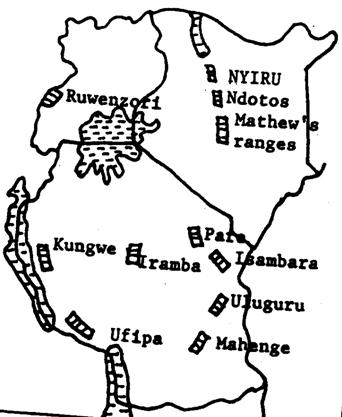
Rock
Structure and Relief.
Although the term Rock Structure is
generally used to mean all the ways in which differ from each other in their
physical and chemical characteristics, strictly in the in sense, rock structure
refers to the attitude of rocks, ie. the nature of dips, their folds £ Other
characteristics such as hardness or softness, permeability, jointing, mineral
oil bedding planes, rock colour, cracks and joints, etc, are known as lithology. The terrace
itself refers to the detailed and minute physical characteristics of a rock.
The
Effects of Structure.
Rock structure as defined in the modem
sense affects the general pattern of relief
(a). In Ankole, the influence of
structure is very apparent on the general relief. Hen Cambrian Karagwe-Ankolean
rock system was affected by cross folding, which was by synorogenic granitic
intrusion along axes of structural arches i.e dome like granite intruded where
normal crests (anticlines) and cross folds intersect. Denudation which affected
these structures have led to the formation of the characteristic 'arenas' in An
(b). On the
Resistance of a rock to erosion also
depends on whether the rock is massive, or m massive structure is one where
there are no joints. Such a massive rock is able to which erosion because water cannot penetrate to
cause chemical weathering. Besides, temperature
changes cannot easily breakdown the rock. Areas made up of such massive
rocks re upland areas.
In
Effects
of Lithology.
The main features of lithology that
influence the details of relief are rock hardness permeability and dipping.
Rock
Hardness.
Although it is not easy to measure the
resistance of a rock to denudation (weather erosion), it is fairly obvious that
areas of hard rock will form uplands while areas of will form lowlands.
Pre-Cambrian granitic intrusive are hard rocks, and wherever the in East Africa, they have formed residual
hills or inselbergs that stand up abruptly for surrounding plains e.g Ngeta
rock near Lira, Bondo rock in Arua, Maragoli hills and in Kenya.
The influence of
rock hardness on relief (D35)
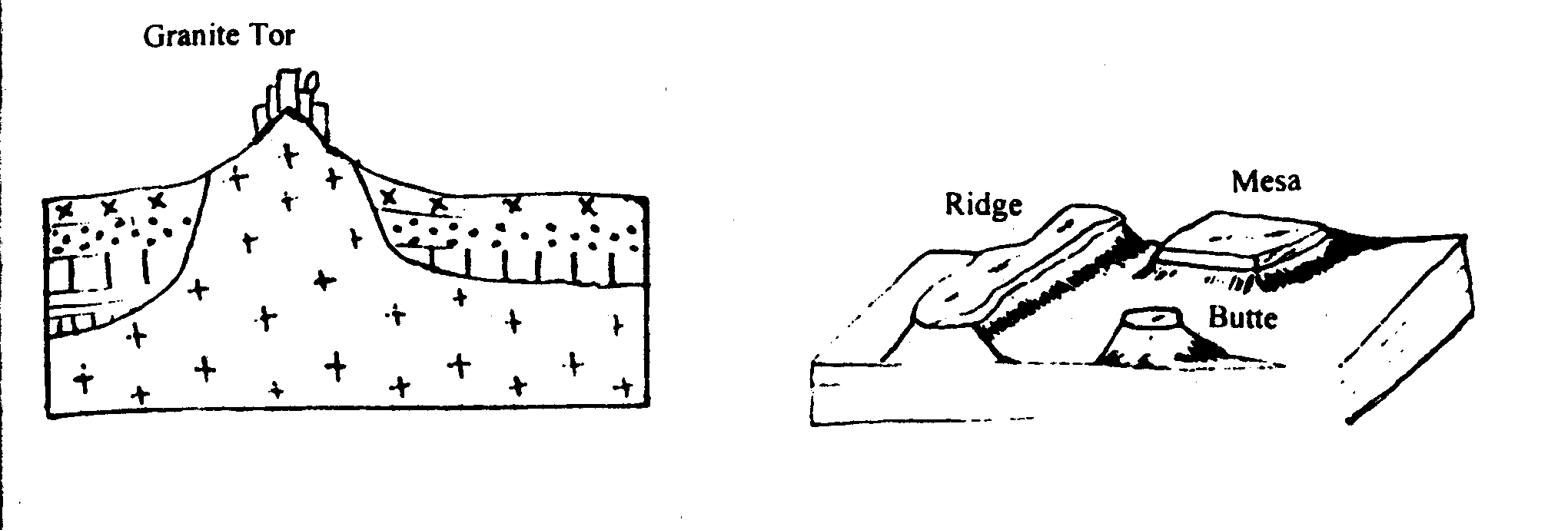
Rock hardness also influences the nature of hill slopes.
Hills made up of hard rocks have convex
slopes while hills made up of soft easily eroded rocks have concave slopes.
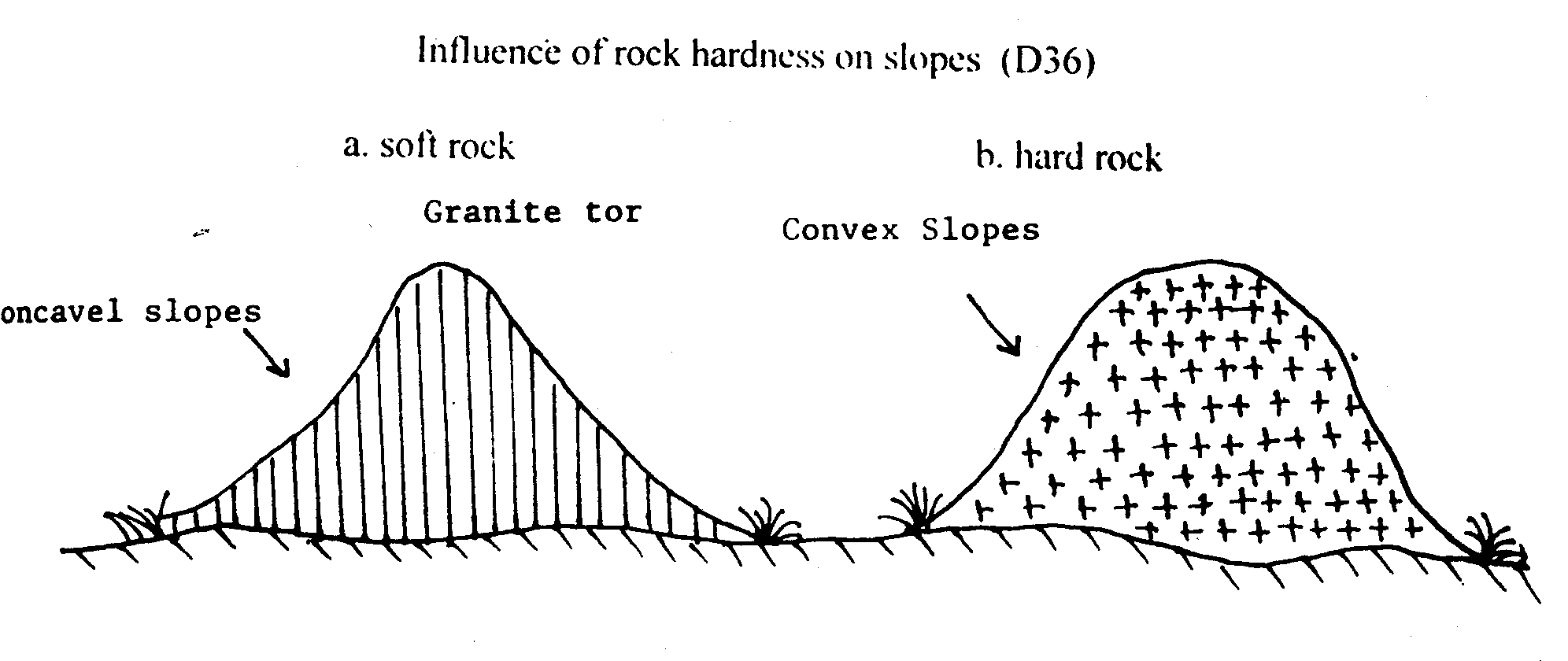
Joints,
Cracks and Bedding Planes.
Both physical and chemical weathering takes place readily in rocks which are jointed, have or bedding planes. Thermal expansion and contraction quickly widens the joints or leading to block disintegration. Plant roots growing in joints and cracks also quickly use the rocks to break.
Water penetrating through joints, cracks and
bedding planes also lead to chemical break down of the rocks. I lard rocks like
granite when jointed quickly disintegrate to the above reasons. In cold areas
such as on top of the snow capped Rwenzori.
In
(i) Granite
(ii) Limestone
Granitic rocks are either a by-product
of igneous intrusion or metamorphism. cracks and joints are produced either by
contraction on cooling, or by pressure re Weathering along the joints has
produced granite tors which are
characteristic Maragoli hills, and
In
Grykes,
Clints, Dolines, Stalactites and Stalagmites in a limestone area
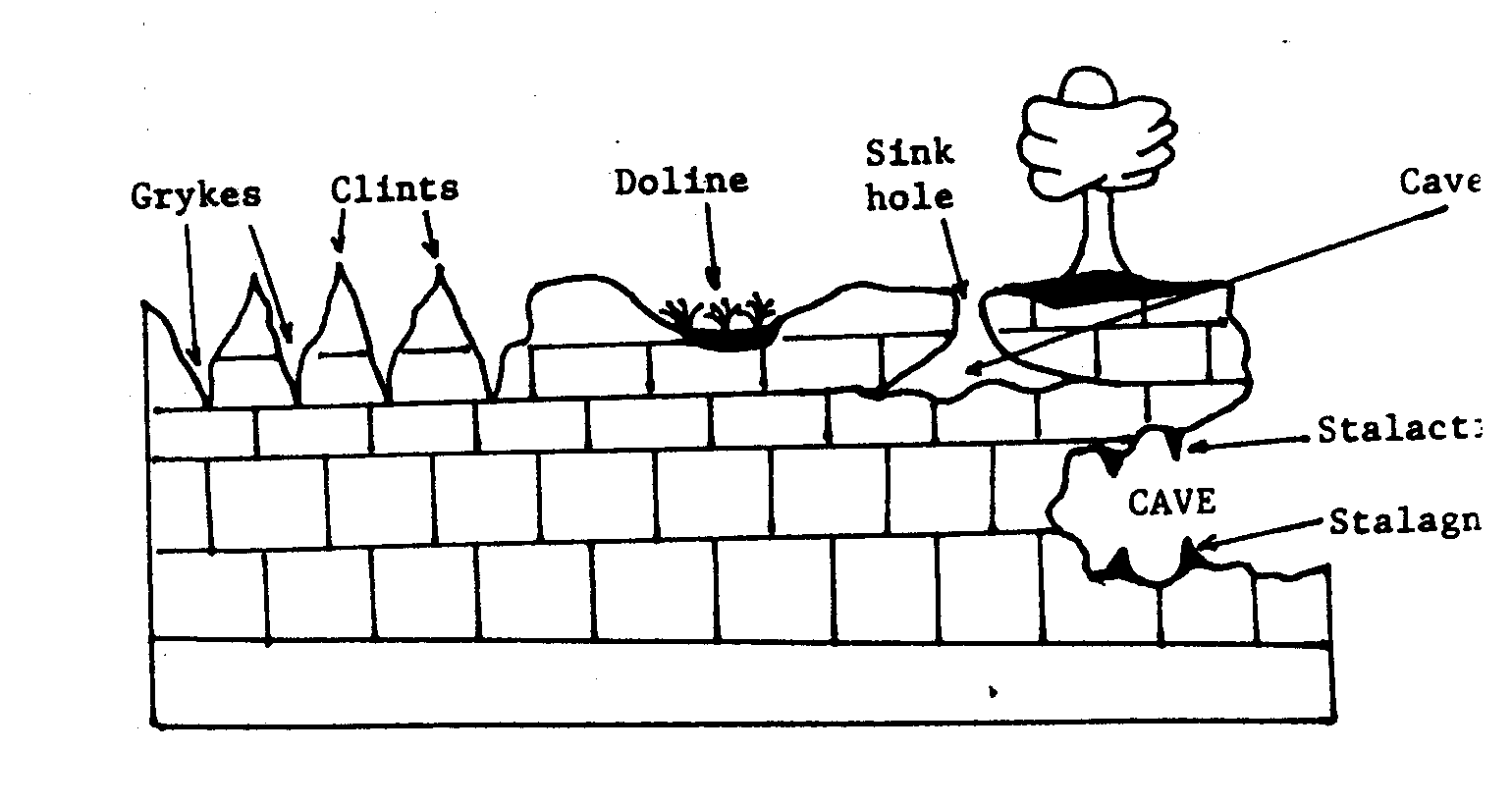
Permeability.
Running water is the main agent in the
erosion of the land. Rocks which allow through reduce the amount of run-off. In
this way, such rocks reduce the amount the surface. Permeable (porous) rocks
therefore form uplands while impervious quickly worn down by running water.
Limestone rocks illustrate the effect of pe . In East Africa, most areas of
limestone form uplands e.g Kambe rock at Kilifi, B Mombasa, Wazo in Tanga,
Sukulu hills in Tororo, Kalyango hills in
Relations
between limestone and surrounding less permeable rocks (D38)
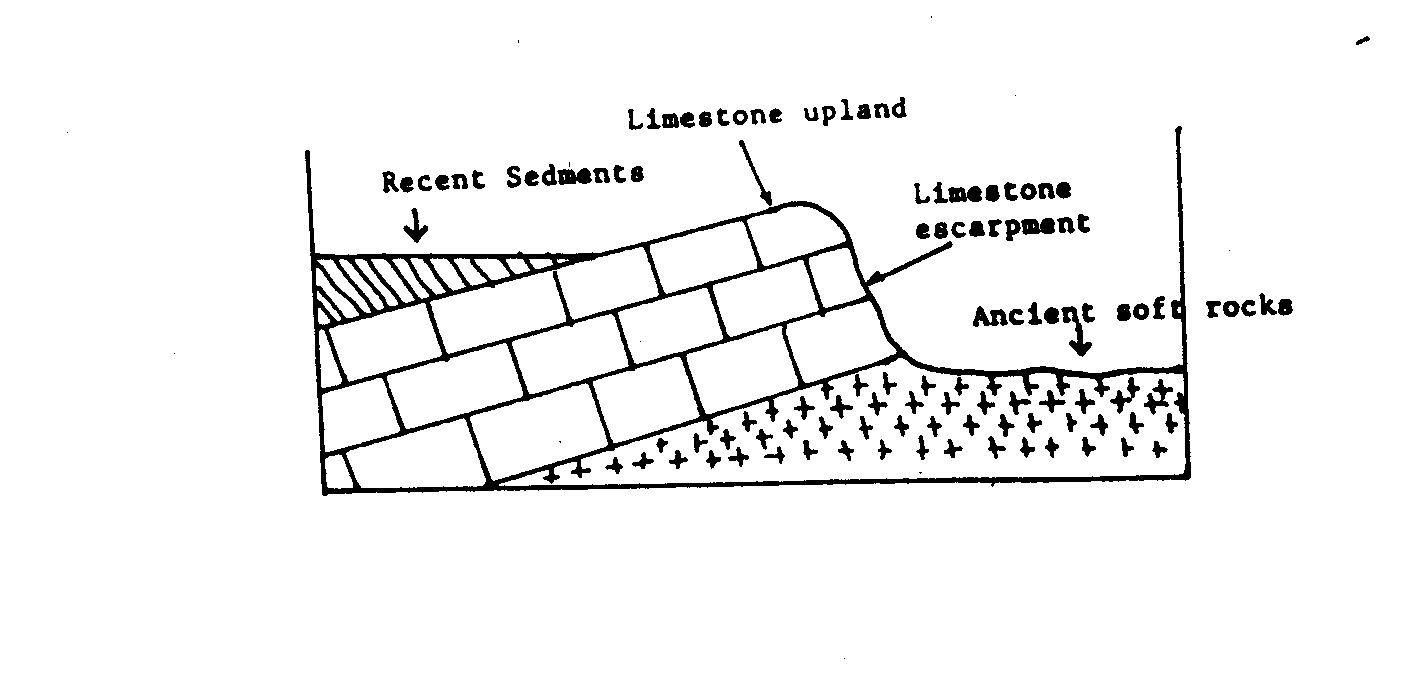
The
Effect of Dip.
The degree of dipping or slope is
important on relief development. Denudation is faster on a steep dip than on a
gentle dip. The result is that steeply dipping beds quickly become lowland
areas while gently dipping beds remain uplands.
This factor is not well illustrated in
Practical Consideration of Effects of Rock Types and Rock
Structure on Relief.
It should be noted however, that in
practice, the various ways in which rocks influence relief are rarely isolated.
No single rock type, structure or lithology remains uniform (homogeneous) over
a wide area; in fact most of them change over very short distances. As a
result, it is difficult to generalise about the effect of rocks on relief.
Other Factors that Influence Relief.
Several other factors also influence
relief and land forms. All those factors must be considered together and not in
isolation since they operate in close association with each other. Of these
other factors, the following are the major ones:
Climate.
The influence of climate on relief and
land forms is ubiquitous. Weathering and erosion are directly accomplished by
elements of climate, and they result in the development of various relief land,
forms such as Karst topography (limestone features), inselbergs etc.
Earth
Movements.
Faulting, folding, uplift, down warp and
other forms of crustel movements result into the formation of various relief
land forms. Block mountains, downwarped basins, escarpments, rift valleys, etc.
are the results of earth movements.
Economic
significance of rocks,
Whether one likes or not rocks are
indispensable in the process of economic development. Already we have seen that
the crystal rock comprises a variety of minerals. Most importantly it depends
primarily to the extent the soil has been produced by weathering processes. In
addition, the time the rock has taken to form.
Thus it has been found that other things
equal the old and hard rocks have almost no soil, whereas newer rocks (those
being formed) tend to produce deeper and are easily worked upon. This is true
of sedimentary rock types. Thus rocks directly or indirectly contribute to
development of the following, ways:
Provide
minerals. Some rocks contain minerals—-which are very precious. Such rocks
are today mined to produce materials
which are used in industries. Some of them like copper at Kilembe mines is used
in several ways in the country. Tororo limestone is no exception it provides
another good examples, in which cement is made. There are many other examples
on this.
Quarrying
purposes. Rocks which do not contain precious stones often provide good
material for many other uses. Among these uses, the following are included;
Road construction, building purposes for example dam's house and bridge
building. Today clay works in particular brick, making industry is increasingly
becoming significant in most urban centres of
For these reasons they are often preferred
by the local population. In
One of the most important in Kajansi,
some 12 kms (10m) south of
In here there are many forms of clay
works. They include pottery;
Weathered
rocks. Rocks which have been weathered for a long time-become, useful
in many ways: For Instance in Agriculture. Most deeply weathered rocks, provide
deep fertile soils which are good for crop growing and above all easy to
cultivate on igneous rocks are well known for this. These are types of soils
found on volcanic areas of
Quarrying. Road building
again benefits very much on soils which have been weathered through leaching.
Most roads of tropical
Source
of power. Some rocks are extremely very useful in that they contain
minerals that can provide power in form of fuel to run industries. Among this
group Iron, coal, uranium, oil are found.
Water
supply. The amount of water found in the ground depends upon the nature
of rock underground. This is because rocks affect water supply in the following
ways:
Circulation of ground water.
Their formation for example springs,
wells etc.
Drilling in order to reach the water
table.
The existence of natural or artificial
reservoirs. Their competence to retain run-offs. It is true that if the surface
rocks are impermeable and there is no chance of water sinking into the ground.
But of course if the underground rocks
are hard enough then ground water can be retained for a long time. Many times
we have heard people complaining that water from some boreholes is hard or
something of that sort. This is in fact the effect of the rocks in which the
water is in contact with
Salts. Some
rocks contain salts.
Phosphates and bicarbonates are particularly important of
this. In many parts of the world
large deposit of salts are found existing in the form of the rock-salts mentioned
above. In East Africa' salt pans are common in dry areas like in North Eastern
parts of Uganda, and Northern parts of Kenya.
They have been formed here because of constantly high temperatures found here. In other parts of Africa, extensive deposits
of salts are found in
Feet
rubbing. Though ordinary as it may look, feet rubbing has been going on
since time memorial. Rock pumice got from volcanic eruptions is essentially
used to clean feet. Today its use is becoming common in Urban centres. These
rocks are suitable for this purpose because it is light and fairly rough to
remove any crack and dirt that way be found on the foot. The effect of rubbing
feet is to make one smart and healthy.
So this being
essential to life
these rocks have attracted many people and as such they are
today found in most markets especially in large towns of East Africa.
Beautiful
sceneries. The major prominent features are
fundamentally existing because of rock that makes them. Two
of these rock types are metamorphic and igneous. The major mountains of